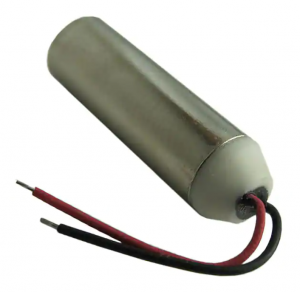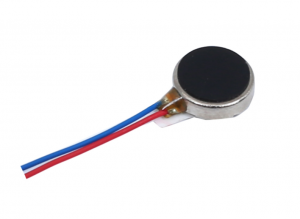Table of Contents
ERM Motors
ERM (Eccentric Rotating Mass) motors are a form of vibration motors that work by spinning an off-center mass. The radial forces that are generated from this movement cause the motor to oscillate back and forth, resulting in vibration. ERM motors are very affordable options for generating simple vibrations.
Types of ERMs
There are three main types of ERM motors: Shafted motors, encapsulated cylindrical motors, and shaftless motors.
Shafted motors are ERM motors for which the eccentric mass is visible. When using shafted motors, it is important to ensure that nothing comes in contact with the eccentric mass while it is spinning. If this does occur, it could result in a large jerk instead of a smooth vibration, in addition to possibly damaging whatever came in contact with the eccentric mass.
Encapsulated cylindrical motors are similar to shafted motors, but they cover the rotating shaft in order to prevent interference of outside objects with the eccentric mass.
Shaftless motors, also known as “coin” or “pancake” motors, are thin coin-shaped motors in which the eccentric mass is enclosed. Because these motors can be much smaller than the other shafted motors, they are often used for wearable haptic displays.
Advantages & Disadvantages
ERM motors are fairly simple, reliable, and affordable, making them popular choices for haptic displays. The actual motor of an ERM motor is a DC motor, which makes it very easy to connect ERM motors to microcontrollers such as Arduinos.
One main disadvantage of ERM motors is that the frequency and amplitude are linked together. If the motor is spinning slowly, it will have a low frequency and amplitude, and if the motor is spinning quickly, it will have a high frequency and amplitude. For applications in which it is important for the frequency and amplitude to be independently set, ERM motors are not suitable choices.
Another disadvantage of ERM motors is that because they use DC motors, their response time is fairly high. This means that they may not be suitable for applications in which they vibrate with accompanying audio.
ERM Examples
There are many inexpensive ERM motors available on DigiKey. Three examples are shown in the table below.
| Type | Manufacturer | Cost | Link |
|---|---|---|---|
| Shafted Motor | Vybronics, Inc | $7.68 | Digikey |
| Encapsulated Motor | Vybronics, Inc | $5.29 | Digikey |
| Shaftless Motor | Seeed Technology Co., Ltd | $1.76 | Digikey |
The above motors generally work as expected, but can sometimes have noticeable variations between identical motors. Higher quality ERM motors with more consistent motor characteristics are produced by companies such as Precision Microdrives. To see a catalogue of their available ERM motors, visit Precision Microdrives Catalogue.
Projects Using ERMs
There have been many projects in music technology that have used ERM motors. Listed below are some notable examples.
- Joanne Armitage and Kia Ng from the University of Leeds created a haptic interface of 16 ERM motors presented as a grid array to augment the physical nature of live performances. 4)
- Researchers from Matralab, a group at Concordia University, worked on a project entitled :body:suit:score: in which a full-body suit was created to be worn by musicians. This suit had ERM motors embedded into the arms, vest, belt, and legs of the suit, so that musical information could be communicated to musicians as they play their instruments. 5)
- Emma Fried and members of the IDMIL lab at McGill University created a wearable tactile display consisting of ERM motors to be placed on a person's back. This tactile display acted as a tactile notification system to be used in the context of live-electronics musical performances. 6)
- Luca Turchet, Travis West and Marcelo Wanderley developed music haptic wearables consisting of two armbands, each with two ERM motors, in order to augment the experience of live musical performances for audience members. 7)
A simple search on Google Scholar can reveal many more examples of music tech projects that make use of ERM motors, showing that these motors are accessible and effective at communicating tactile feedback to users.
External Links
The following paper by Choi and Kuchenbecker gives a great overview of vibrotactile displays, how vibrotactile feedback is perceived by humans, more detail into the different vibrotactile technologies, and various applications:
S. Choi and K. J. Kuchenbecker, “Vibrotactile Display: Perception, Technology, and Applications,” in Proceedings of the IEEE, vol. 101, no. 9, pp. 2093-2104, Sept. 2013, doi: 10.1109/JPROC.2012.2221071.
To understand more about the theory behind ERM motors and how they work, Precision Microdrives has a great webpage that discusses this in detail:
“AB-004: Understanding ERM vibration motor characteristics,” Precision Microdrives, 01-Feb-2022. [Online]. Available: https://www.precisionmicrodrives.com/ab-004. [Accessed: 17-Mar-2022].



